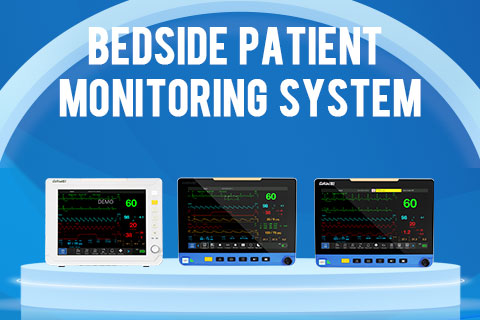A patient monitoring system is a system or device that helps healthcare providers to monitor physiological signals of a patient's health. It is used for observation and measurement of patient's health parameters such as heart rate, respiratory rate, temperature, blood-oxygen saturation, and many other parameters of critically ill patients. Such accurate and immediate information are useful for making crucial decision for effective patient care.
WHAT IS A PATIENT MONITOR?
A patient monitor is a device used to record, measure and display multiple biometric values such as heart rate, blood pressure, body temperature, SpO2 and more. The patient monitoring device can be used to monitor the health conditions of infants as well as adults.
HOW TO READ A PATIENT MONITOR?
The sensors connected to the patient's body carry the information that is displayed on the patient monitor. You can read the parameters such as heart rate, blood pressure, body temperature, oxygen saturation displayed on the machine. Here's how you can interpret the numbers shown in the display -
Heart Rate: Typically, the resting heart rate of a healthy adult is between 60-100 beats per minute.
Blood Pressure: Blood pressure numbers in the range 120/80 are considered to be normal.
Body Temperature: Temperature is reported in degrees Fahrenheit or degrees Celsius. It can be anywhere from just under 98 degrees F to a little over 99.
Oxygen Saturation (SpO2): It is the measure of the amount of oxygen in the patient's blood. The SpO2 is normally 95 or higher.
Respiratory Rate (RR): A resting adult typically breathes 12 to 16 times a minute. It is reported in breaths per minute.
WHAT ARE THE 5 PARAMETERS OF PATIENT MONITOR?
The 5 parameters of a patient monitor are ECG, body temperature, respiratory rate, SpO2 and blood pressure.
WHAT ARE THE TYPES OF PATIENT MONITORING SYSTEMS?
The two broad types of patient monitoring systems are bedside patient monitoring systems and remote patient monitoring systems.
Bedside patient monitoring systems
Bedside patient monitoring systems are also referred to as hospital patient monitoring systems. They are used within the hospitals to monitor patients in ER as well as intensive care settings. Bedside patient monitoring systems are not just required for patients in trauma but also for long-term patient monitoring for vital signs to prevent complications and to ensure full recovery.
Remote patient monitoring systems
A remote patient monitoring system is used to monitor patients outside of the hospital i.e remotely. It is also referred to as home patient monitoring system. It enables healthcare providers to monitor a patient's health outside of the hospital. It helps them to track real-time changes in a patient's health data from a distance and use it in planning treatment for the patient.
WHY IS PATIENT MONITORING IMPORTANT?
Patient monitoring is important because it gives us a warning of early or dangerous deterioration of a patient's health so that practitioners can make the necessary changes in their treatment accordingly. The real-time data helps doctors to prioritize their patients and provide urgent care to those who need the most danger thereby saving lives.
WHAT ARE PATIENT MONITORS USED FOR?
Patient monitors are used for continuous measurement of patient parameters such as heart rate and rhythm, respiratory rate, blood pressure, blood-oxygen saturation and many other parameters to take care of critically ill patients.


